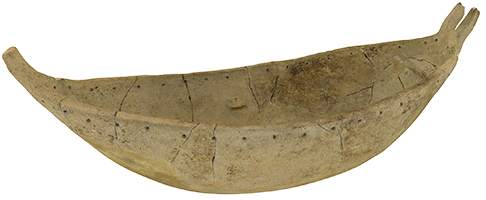Deep and beamy crescentic hull with a flat topped incurving sheer. On either side of the hull is a marked protruding stripe that runs between the stems and follows the sheer, perhaps representing a wale. Just below the gunwale (c. 1 cm below) is a row of evenly spaced horizontal holes running from stem to stem on either side (37 on one and 38 on the other side respectively). These were pierced prior to firing. The keel is rendered as a narrow molded bar running the length of the ship, rectangular in section and projecting into the hull. It widens toward the stems to a width of about 2 cm. One of the stems is partially broken. The intact stem projects about 6 cm high above the gunwale. It is flattened frontally, widens towards its upper extremity and ends in a flat, horizontal edge. It has two pierced holes arranged horizontally. On the inner side of the damaged stem are seven protruding "buttons" c. 1 cm in diameter. The upper two are at the same level horizontally, while the remaining five are placed in a vertical row below them. Wachsmann argues that this is the sternpost, and that although it is broken it should be reconstructed in a bifurcated manner, as on the very similar model from Maroni. There is a circular mast socket amidships 3.5 cm in height and 3 cm in diameter. On either side of the mast socket (7cm and 9 cm from the keel plank) is a bollard or belaying pin, one of which is partially damaged. These hooks likely served as an internal structure to attach lateral cables to the ship's hull, or possibly the stays. Basch thinks that the boat was actually made of hides on a wooden framework, with the row of holes below the gunwale used for passing the ligatures (unconvincing).
Ship model
C7
end of LC I - end of LC II (1650-1200 B.C.)
Kazaphani tomb 2 B, Ayios Andrionikos
L: 45 cm; H (amidships): 15 cm; beam (amidships): 20.5 cm
Terracotta model, red clay, no painted decoration
Nicosia Archaeological Museum no 249 + 37
Amico et al 2018; Basch 1987: 70-72, nos. 138-141; Carbillet 2011: 288, fig. 5; Courtois 1989: 102-103; Dikaios 1961; Dolan 2023: 319-322, no. 5; Göttlicher 1978: 37, no. 167, pl. 12:167; Gray 1974: G 19, G 46, pl. G. II c, d; Karageorghis 1964: 21-23, fig. 70 a,b; Knapp 2019: 142; Merrillees 1968: 188; Nicolaou and Nicolaou 1989: 52-53, fig. 14, pl. XXXIV; Wachsmann 1998: 63, 65, fig. 4.5; Westerberg 1983: 11-12, no. 5, 80, fig. 5
From chamber tomb 2b, designated as such for sharing a common dromos with another tomb. Tomb 2a was the principal chamber leading directly from the dromos, while tomb 2b was annexed on the right side of the dromos. Tomb 2b is nonetheless much more spacious and rich in terms of funerary gifts, containing over 500 objects. Both tombs have been looted, as indicated by pottery joins from the two chambers. As a result metal objects are seriously underrepresented, including one gold earring, a few other crescent shaped silver earrings, and small objects of bronze. Tomb 2b contained a great variety vases, including White-Painted VI, Red Lustrous, White Slip I and II, and Base-Ring I ware. Bull shaped rhyta and askoi were also recorded, as well as some Mycenaean imports. The boat model is considered as the most outstanding and unusual offering in the tomb.
Amico, N., P. Ronzino, V. Vassallo, N. Miltiadous, S. Hermon and F. Niccolucci. 2018. “Theorizing Authenticity – Practising Reality: The 3D Replica of the Kazaphani Boat,” in P. Di Franco, F. Galeazzi and V. Vassallo (eds.) Authenticity and Cultural Heritage in the Age of 3D Digital Reproductions. McDonald Institute Conversations. Cambridge: McDonald Institute for Archaeological Research, pp. 111-122.
Basch, L. 1987. Le musée imaginaire de la marine antique. Athens: Institut Hellénique pour la preservation de la tradition nautique.
Carbillet, A. 2011. “Naviguer vers l’éternité. Les modèles de bateau en terre cuite chypriotes et leur association à la navigation eschatologique,” CCEC 41: 223-238.
Courtois, J.-C. 1989. “Appendix I: Notes et commentaires sur les céramiques et objets provenant du mobilier funéraire de la tombe 2A, B à Kazaphani - Ayios Andronikos.” In : Kazaphani: A Middle/late Cypriot Tomb at Kazaphani--Ayios Andronikos: T. 2A, B. Nicosia: Republic of Cyprus Department of Antiquities.
Dolan, M. 2023. Ceci n'est pas un bateau: Reassessing terracotta boat models in Late Bronze and Iron Age Cyprus. University of Southhampton. Unpublished DPhil Thesis.
Göttlicher, A. 1978. Materialien für ein Korpus der Schiffsmodelle im Altertum. Mainz: Philipp von Zabern.
Gray, D. 1974, Seewesen. Göttingen: Vandenhoeck und Ruprecht.
Karageorghis, V. 1964. “Chronique des fouilles et découvertes archéologiques à Chypre en 1963,” BCH 88.1: 289-379.
Knapp, A. B. 2018. Seafaring and Seafarers in the Bronze Age Eastern Mediterranean. Leiden: Sidestone Press.
Merrillees, R. S. 1968. The Cypriote Bronze Age Pottery Found in Egypt (SIMA 18). Göteborg.
Nicolaou, I. and K. Nicolaou. 1989. Kazaphani: a middle/late Cypriot Tomb at Kazaphani--Ayios Andronikos: T. 2A, B. Nicosia: Published for the Republic of Cyprus by the Department of Antiquities, Cyprus.
Papadopoulos, A. 2018. “The Iconography of Late Helladic IIIA-B Pictorial Kraters and Wall-paintings: A View from the Aegean and the Eastern Mediterranean,” In A.Vlachopoulos (ed.) Paintbrushes. Wall-Painting and Case-Painting of the Second Millennium BC in Dialogue. Athens: Hellenic Ministry of Culture and Sports, pp. 523-531.
Wachsmann, S. 1998. Seagoing Ships & Seamanship in the Bronze Age Levant. College Station, TX: Texas A&M University Press.
Westerberg, K. 1983. Cypriote Ships from the Bronze Age to c. 500 B.C. (SIMA, Pocket-books, 22). Göteborg: P. Åströms förlag.












